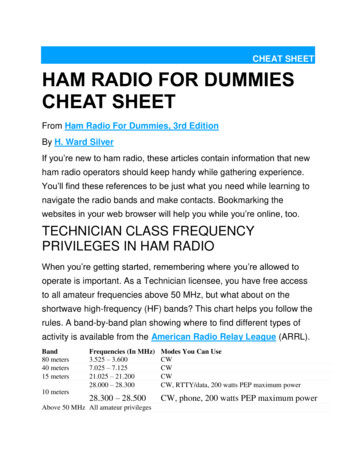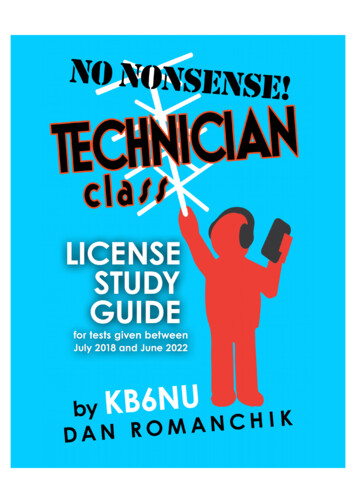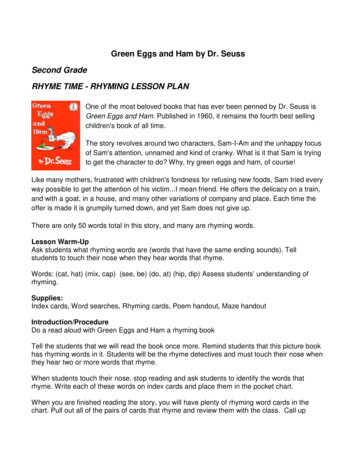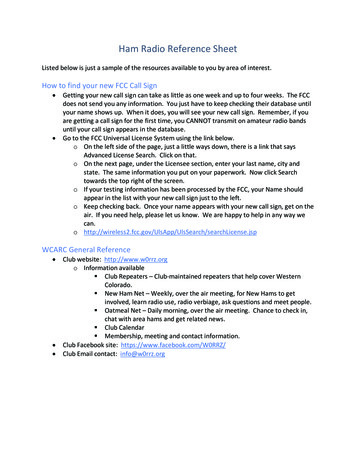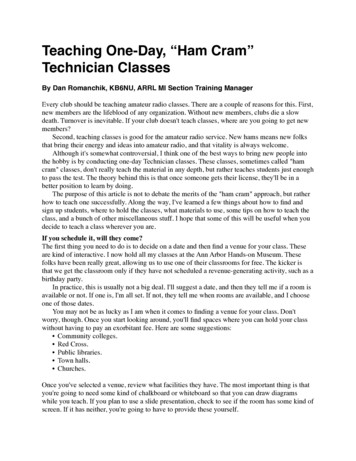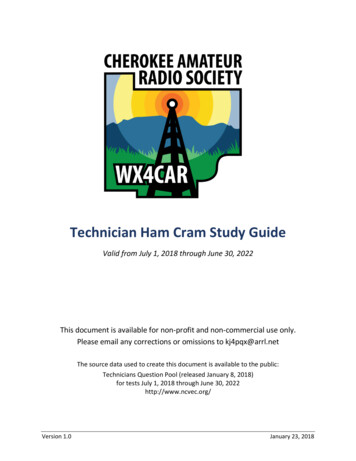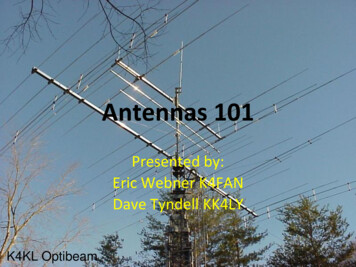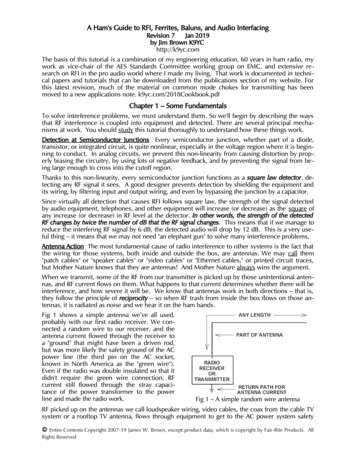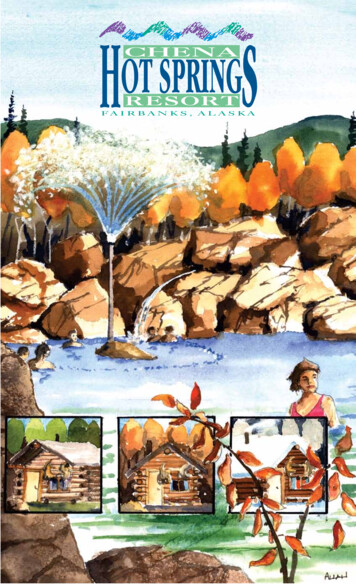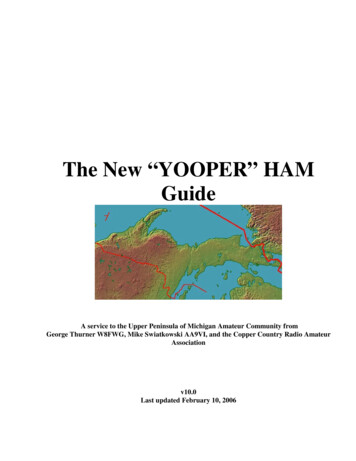
Transcription
The New “YOOPER” HAMGuideA service to the Upper Peninsula of Michigan Amateur Community fromGeorge Thurner W8FWG, Mike Swiatkowski AA9VI, and the Copper Country Radio AmateurAssociationv10.0Last updated February 10, 2006
Table of ContentsWelcome .3Keweenaw Peninsula and U.P. Club Contact Information 3Frequently Asked Questions .5Details about Amateur Organizations .9W1AW Code Practice Schedule .11U.P. Amateur Exam Schedule .12ICOM Amateur Radio Band Plan .13Coordinated U.P. Repeater List .14U.P. 2m Repeater Map .15Skywarn Information 16NOAA Weather Radio Frequencies .17Michigan Scanner Law .182
WELCOME TO HAM RADIO!Hello.Glad to hear from you! With this all-new edition, we’d like to acquaint you with the radioclubs of the Copper Country, and at the same time answer some of your questions that you may haveabout the “Space Age” hobby.We have three active organizations in the Keweenaw Peninsula, and they are:Copper Country Radio Amateur Assoc.P.O. Box 217Dollar Bay, MI 49922-0217Keweenaw Co. Repeater Assoc.225 Kearsarge StreetLaurium, MI 49913-2109(906) 337-2542w8cdz@arrl.nethttp://ccraa.net(906) 337-2542w8fwg@pasty.nethttp://kcra-mi.netHusky A.R.C.EE Dept. - MTUHoughton, MI.(906) 487-1303w8yy@mtu.eduhttp://www.sos.mtu.edu/w8yySee page 9 for more details on these organizations. If you’d like to know more about ham radio justcome to one of the regularly scheduled meetings of these groups.AARC-K8KIT-145.410Alger Amateur Radio Clubc/o Raoul Revord, W8RDRN3253 Buckhorn Rd.Wetmore, MI 49895rrevord@up.netOther U.P. clubs’ contact information:ACARN-W8ARSAlgoma-ChippewaARES/RACES Network1412 MinneapolisSault Ste. Marie, MI 49783N8JAT@arrl.netWeb Page: algerham.orgALGER CW MARAUDERS-NA8CWc/o Paul E. Genaw, K8PG3664 E. Hallstromn St.Box 220Chatham, MI 49816E-Mail: pegenaw@charter.netCUPRA-KG8ZL/R-147.090 Central U.P. R.A.147.090 Ishpeming444.200 (N8PUM/R) Negaunee147.030 (W8ZUL/R) ChampionCentral U.P. R.A.c/o B. Anderson, N8PUM1015 School St.Ishpeming, MI 49849n8pum@arrl.netBARA-K8ATX-146.760Blackjack Radio Amateur Assoc.c/o R. Warczynski, K9RON122 Superior AvenueMerriweather, MI 49947ronski@portup.comDCARS-K8ZAS-147.150 Delta County Amateur Radio Societyc/o R. Thompson, N8OYR9560 Chaison N5Gladstone, MI 49837ricthompson@uplogon.com3
HARA-K8LOD-146.910Hiawatha Amateur Radio Assoc.c/o Richard E.B. Schwenke, N8GBA21 Smith LnMarquette, MI e Amateur Radio Clubc/o David B. Hopper, KA8K27872 West M28Eckerman, MI /Marinette Clubsc/o L. Rynish, N8OSKPOB 1082Marinette, WI A-K8ONTMarquette Repeater AssociationOntonagon County Repeater Assoc.c/o Mike Hoffman, KE8ILc/o Al Trainer III132 Juliet Street26715 Hokkannen RdMarquette, MI 49855Ontonagon, MI 49953ke8il@arrl.netkc8ont@qsl.netOVER THE AIR RAD. CLB UPR PEN.-KC8LVV SARA-W8UXG-146.730c/o Howard B. Schweppe, N8MOSSuperior Amateur Radio Association47 Elder Drivec/o R. Reid, W8UXGMarquette, MI 49855101 Third St.N8MOS@aol.comOntonagon, MI .360/444.950Superior Peninsula Amateur Radio KlubTrenary Amateur Radio Associationc/o M. B. Ennis, KA8CEOc/o Freddy J. Miller, W5TJCPOB 446HCR1, Box 110Newberry, MI 49868Trenary, MI rap Hills Amateur Radio ClubUpper Peninsula DXc/o Jeffrey K. Bjurstromand Contest Club3543E M28NV8NTrout Creek, MI 49967N8GZQrenhoek33@yahoo.comEUPAR-W8EUP-147.210 Eastern U.P. A.R.C.c/o David P. Dietrick, WA8OLD220 Hursley St.S.S. Marie, MI 49783iceman@30below.comIRARC-KC8MEC-145.170Iron River A.R.C.c/o Dan Waters,AA9JG3338 US Hwy 24Iron River, MI 49935dmwaters@up.netMARCKC8VCW3821 Waucadah Rd.Vulcan, MI 49892mikebray@charter.net4
Q1. WHAT IS HAM RADIO?A1. Amateur radio or “ham” radio as it is called; is communicating. Hams, who must be licensed by thefederal government, operate two-way radio equipment from their homes, cars, boats, etc. to other hamsacross town, across the country and even across the world and recently with spacecraft orbiting the earth.They use Morse code, voice, digital communications and some even have their own amateur televisionstations.Q2. WHAT ARE THE REQUIREMENTS FOR OBTAINING A HAM LICENSE?A2. Any citizen of the United States may become a ham by taking a written and/or Morse codeexamination and obtaining a passing grade to earn their license.Q3. WHAT ARE THE EXAMS LIKE?A3. The written tests are made up of elements, and are of the multiple-choice type, with four answersgiven; one of which is the correct one. A passing grade is 74 percent (26 out of 35 questions answeredcorrectly on the Technician and General exams and 37 out of 50 on the Extra class exam). The Morsecode test can be passed by answering 7-out-of-ten questions correctly (70%), or by copying one-minutesolid at the prescribed speed. (That means 25 consecutive characters at 5 words-per-minute.)Q4. HOW MANY CLASSES OF AMATEUR RADIO LICENSES ARE THERE?A4. At this writing there are three: Technician, General, and Extra.Q5.A5.WHAT ARE THE REQUIREMENTS OF EACH CLASS?See table 1 (below)TABLE 1CODE ELEMENT #/WPMTECHNICIANGENERALEXTRAWRITTEN ELEMENT #/Questionsnone1/ 5no additional2/ 353/ 354/ 50Note 1: For frequency privileges below 30 MHz, a 5 words per minute code test is required. (Element 1).Above 30 MHz, no code is required.Q6. WHAT IS THE ‘NO-CODE’ TYPE OF HAM LICENSE?A6. The new “Codeless-Technician” class of license, sometimes called “Tech-Lite”, was introduced onFebruary 14, 1991. It consists of only a written element (Element with 35 questions). No Morse code isrequired for this license. A passing grade is 74% on each element.Q7. HOW MUCH DOES AN AMATEUR RADIO LICENSE COST?A7. At this writing the charge to take the exam is 14. You can continue to take additional elements forfree as long as you pass the previous exam element.5
Q8. WHAT IS THE TERM OF A HAM RADIO LICENSE?A8. It is good for 10 years with a 2 year period of grace, and renewable without testing. After 10 yearsthe license is no longer valid, but it may be renewed within the next 2 years.Q9. WHAT METHODS OF STUDY ARE AVAILABLE TO PREPARE FOR TESTING?A9. Several methods are available. They are:A. Home study, using a textbook and/or computer assisted instructions.B. Home study, via the Internet. (Download sample exams)C. Video course from ARRL.D. Classroom study.A. HOME STUDY, USING A TEXTBOOK: This is the most convenient if you have limited time. Youmay study whenever you have the extra time. If you have some electronics background, from anotherfield or service time this may be for you.B. HOME STUDY, VIA THE INTERNET: There are several good sources of information (check theARRL web page at: http://arrl.org/ and you will find these sources). Using your personal computer athome will again allow you to study when time permits. Try to establish a regular time schedulehowever, as we’ve found out this works best.C. VIDEO COURSE FROM ARRL: The CCRAA has courses on video tape for the Technician,General and Advanced Class licenses. They may be obtained from the Education Committee Chairmanat (906) 337-2542 (George, W8FWG). The tapes come with computer software, enabling you to checkyour progress at home, with sample exams provided.D. CLASSROOM STUDY: Two of the organizations, (CCRAA and HARC) offer courses ofinstruction from time to time. They vary from a few days to a full 12 week course. Each student isexpected to buy a textbook, but other than that, there is no charge for the courses.Q10. IS AN AMATEUR RADIO LICENSE EVERY SUSPENDED OR REVOKED?A10. On rare occasions! Part 97 of the Rules and Regulations must be adhered to, however. It wouldtake a very serious violation to result in a suspension or revocation of a license.Q11. WHERE AND WHEN ARE THE AMATEUR RADIO EXAMINATIONS GIVEN?A11. Nationally, they are given by hundreds of radio clubs throughout the United States and itspossessions. Here; in the Upper Peninsula of Michigan they are given several times per year, by fourradio groups: 1. CCRAA, 2. HARC. 3 W5YI group. (In Iron Mountain) and 4. HARA (in Marquette).A copy of this year’s schedule is attached to this document!Q12. IS THERE A NATIONAL ORGANIZATION OF RADIO HAMS?A12. Yes, the American Radio Relay League, located in Newington, Connecticut.6
Q13. IS THERE AN AGE LIMIT IN BECOMING A RADIO “HAM” ?A14. No. People of all ages and from all walks of life, men, women and children have become hams.The ages range from age 5 to age 80!Q14. MAY I OBTAIN COPIES OF THE QUESTIONS USED IN THE EXAMS?A15. Yes, they are now public domain, and anyone can obtain them. (The Internet is a good source.Again check: http://www.arrl.org They are also available in the study guide entitled: “Now You’reTalking”Q15. WHAT PUBLICATIONS ARE RECOMMENDED FOR HOME STUDY?A16. They are:1. NOW YOU’RE TALKING(ARRL publication)2. FCC RULE BOOK(ARRL publication)3. TECH Q & A MANUAL(ARRL publication)3. STUDY GUIDES(Obtain from the Internet or the FCC)Q16. SUPPOSE I ‘DO’ WANT TO LEARN THE MORSE CODE. HOW DO I DO IT?Q17. A good publication for beginners is: “Morse Code, the Essential Language”. It is available fromthe ARRL. Another way is to copy the code off-the-air from radio station W1AW. The headquartersstation of the American Radio Relay League (ARRL). They give code practice several times daily. (Seethe schedule, included with this work) Audio tapes are available free of charge from the Copper CountryRadio Amateur Association also, that teach the code.Q17. WHO ISSUES THE AMATEUR RADIO LICENSE?A18. The Federal Communications Commission (FCC).Q18. HOW LONG DOES IT TAKE, AFTER TAKE THE EXAM FOR THE LICENSE TOARRIVE?A19. You will receive a paper copy of the license in about a week via the U.S. Postal Service. You canalso obtain your newly issued callsign quicker from the FCC’s website at http://wireless.fcc.gov/uls/ .New callsigns are issued alphabetically in sequential order (examples: KC8GDE follows KC8GDD,KC8GEA follows KC8GDZ, and KD8AAA follows KC8ZZZ). Michigan is part of the 8th callsigndistrict, hence the 8 in the callsign. Wisconsin callsigns have a 9 in them and Minnesota callsigns have a0 in them. Your callsign district is determined by the address on your FCC form 605.Check the FCC’s website daily to see if your name has been assigned to a callsign yet.Q19. HOW CAN I CONTACT THE FCC BY TELEPHONE?A20. You may call them at: 1-888-CALL-FCC. (This is a toll-free Nationwide number).Q20. DIDN’T YOU MENTION THIS WAS A “SPACE AGE” HOBBY?A21. Yes. Once you obtain your Technician Class callsign you might actually speak to astronauts onthe International Space Station or talk to other hams in other states via satellite repeaters all with a7
handheld transceiver. Of course, the more powerful mobile and base station radios help increase theodds of a successful contact. Nevertheless, some lucky hams have needed nothing more than a handheldtransceiver to log a contact from “beyond this world!” To learn more about amateur satellites and the ISSvisit http://www.amsat.org8
THE COPPER COUNTRY RADIO AMATEUR ASSOCIATION, INC.Was formed for the purpose of bringing together people with a common interest. It replaced the formerLake Superior Radio Club, which was active in the 1950's. Monthly meetings are held in the communityof Dollar Bay, at the Fire Hall. A clubhouse south of Calumet houses HF and VHF radio transmittingand receiving equipment. This facility can serve a five-county area, and works with the local emergencyservices to serve as a base of operations, in cases of natural disasters. Emergency power is supplied andcounties of Baraga, Houghton, Keweenaw, Marquette and Ontonagon are covered from this location.This organization has two VHF repeaters (Hancock and Herman) and has regular monthly meetings.Both have the same call sign of W8CDZ.THE KEWEENAW COUNTY REPEATER ASSOCIATION, INC.This group is not a “club” as such, but is a repeater organization, providing its membership with arepeater located on Mt. Horace Greeley in Keweenaw County. It came into being in 1983, for thepurpose of providing radio coverage in this northernmost county in Michigan to help in search andrescue work, and to assist local law-enforcement officials in finding lost hunters, and boaters, on LakeSuperior. It has its own club call sign of K8MDH and operates and maintains a VHF repeater.THE HUSKY AMATEUR RADIO CLUBThis club, on the campus of Michigan Technological University in Houghton is one of the oldest clubsin the area, having started operation in the early 1920's. Composed of mostly students at the University,memberships are available as “associates.” The Husky Amateur Radio Clubs owns and maintainsamateur radio station W8YY and is active in HF, VHF and digital communications. Radio classes areoffered annually, and scholarships are available through the club. This club’s Volunteer ExaminerTeam, in cooperation with the CCRAA gives amateur radio license tests throughout the year.THE A.R.R.L.Those famous initials belong to the American Radio Relay League, founded in the year 1914. ARRL isthe National organization for radio hams. With headquarters in Newington, Connecticut they provideservices such as daily code practice, legal assistance, bulletins of interests to radio amateurs, text books,study guides and a host of other services. As a member of ARRL you will enjoy receiving the monthlypublication QST. Thanks to the hard work of experimenters, the radio “hams” made the League what itis today: our voice in the Amateur Radio Service. They also serve as the International Secretary to theInternational Amateur Radio Union (IARU), which like the ARRL in the United States, has societies in123 different countries throughout the world. The also have Official Observer status in the InternationalTelecommunications Union (ITU), which is a branch of the United Nations, in charge of worldconferences and agreements concerning radio communications.9
THE VOLUNTEER EXAMINER PROGRAMThe “VE” program, as it is called is a group of amateur radio operators who volunteer their time to giveradio exams in the local area, and there are several thousand clubs throughout the United States that dothis. Historically, the FCC gave these exams, but with budget constraints in the Federal government, theradio amateurs themselves took over the job. All it takes is for an individual to fill out a standardapplication form (called an FCC 605 form), and appear at one of the examining points at the time andthe date listed, pay a small fee ( 14) at this writing and complete a series of written and/or Morse codeelements (optional) for a specific class of amateur license.THE FEDERAL COMMUNICATIONS COMMISSIONThis is the law-making and regulatory branch of all radio services within the United States and itspossessions. “Ham” radio is only a small part of the service it regulates. They regulate commercialbroadcast stations, public-safety, television stations and ship-to-shore installations. If you wish tocommunicate with the FCC, they now have one National Call Center. You may reach them at: 1-888CALL-FCC. This is a toll free number.10
W1AW CODE PRACTICE SCHEDULEPacificMtnCentEastMonTueWedFast CodeThu6 am7 am8 am9 amSlow Code Fast Code7-9 am10 am-12:45pm8-10 am11 am-1:45pm9-11 amnoon-2:45pm10 amnoon1-3:45 pm1 pm2 pm3 pm4 pm2 pm3 pm4 pm5 pmCode Bulletin3 pm4 pm5 pm6 pmTeleprinter Bulletin4 pm5 pm6 pm7 pm5 pm6 pm7 pm8 pmCode Bulletin6 pm7 pm8 pm9 pmTeleprinter Bulletin6:45 pm7:45 pm8:45 pm9:45 pm7 pm8 pm9 pm10 pm8 pm9 pm10 pm11 pmFriSlow CodeVisiting Operator TimeFast CodeSlow Code Fast CodeSlow Code Fast CodeSlow Code Fast CodeSlow Code Fast CodeSlow CodeVoice BulletinFast CodeSlow Code Fast CodeSlow Code Fast CodeCode BulletinCode Frequencies are 1.818, 3.5815, 7.0475, 14.0475, 18.0975, 21.0675, 28.0675 and 147.555MHz.Voice Frequencies are 1.855, 3.99, 7.29, 14.29, 18.16, 21.39, 28.59 and 147.555 MHz.Slow Code practice sent at 5, 7-1/2, 10, 13 and 15 words per minute (wpm).Fast Code practice sent at 35, 30, 25, 20, 15, 13 and 10 wpm.Code bulletins are sent at 18 wpm.11
2006 UPPER MICHIGAN AMATEUR RADIO EXAM CW5YIHARAIRARCDCARSCityHoughtonIron MountainNegauneeIron RiverEscanabaTime9 am ET9:30 am CT8:30 am ET6:30 pm CT9:30 am ETLocationHoughton Co. M-T-U WadsworthHallDickinson Co.LibraryMrqt Co. HealthDept.Iron Co. LutheranChurchDelta Co. Bay de NocCommunity CollegeRoomG04 (Basement, Opposite WMTURadio)ConferenceBasement of H.D. US 2/US41TBA (Varies each MarkRichardDanLesTelephone(906) 337-2542 or Mobile: (906)369-2542(906) 774-6598(906) 249-3837(906) 265-4240(906) :All examinees should arrive 1/2 hour before test time to register. Please bring 2 pencils, a pen for the official paperwork, theoriginals AND copies of any previous credit that you have earned (Certificates of Successful Completion or current license), 1photo id (usually a driver's license) and one other id. (usually a birth certificate or SS card), a calculator if needed (make sureyour memories are cleaned out), and the test fee. (2006 fee remains the same as last year, 14).* The Iron River Club (IRARC) will be giving ham exams the third Thursday of each month, right BEFORE their regular clubmeeting. You MUST pre-register for these sessions. If there are no applicants, there won't be any exams given.Abbreviations:CCRAA: Copper Country Radio Amateur AssociationHARC: Husky Amateur Radio ClubHARA: Hiawatha Amateur Radio AssociationW5YI: Iron Mountain Group (No Club)IRARC: Iron River Amateur Radio ClubDCARS: Delta County Amateur Radio Club12
13
EASTERNCENTRALWESTERN2006 UPARRA COORDINATEDAMATEUR RADIO REPEATER LISTINGOutput/Offset146.760 147.315 *442.550 *444.150 146.880 444.500 145.170 444.175 146.670 147.075 147.300 *442.075 146.730 145.210 146.700 145.130 147.150 444.300 *147.240 444.450 *147.195 146.640 146.850 444.850 146.910 444.200 146.970 147.270 444.800 *53.110 147.000 444.075 *444.500 145.410 147.090 147.330 147.030 146.790 147.090 *53.270 146.610 444.900 146.640 444.100 444.375 147.105 147.210 442.850 147.330 LocationBessemerCalumetCalumetCopper HarborHancockHoughtonIron RiverIron RiverL'AnseWakefieldWhite PineWhite dstoneGladstoneGrand MaraisGwinnIron MountainIron ublicStephensonTrenaryWetmoreDeer ParkNewberryNewberryNewberryPickfordSt. IgnaceSt. IgnaceSault Ste. MarieSault Ste MarieSault Ste. Noteso(ca)o a e WX z 100.0o a e WX z 100.0oao e 107.2o e 107.2oexoooaeoo r s WXooooeoeo(ca)e WXo(ca) e 100.0oeoeoeo(ca) WXo a 100.0o e WX 107.2oeoo e-sunoeooo e 114.8o 114.8o 131.8o e WXo (ca)o WX 103.5o (ca) e WX zo a e WXo(ca)e WX zoe
15
SKYWARNSKYWARN is a concept developed in the early 1970s that was intended to promote a cooperative effortbetween the National Weather Service and communities. The emphasis of the effort is often focused onthe storm spotter, an individual who takes a position near their community and reports wind gusts, hailsize, rainfall, and cloud formations that could signal a developing tornado. Another part of SKYWARNis the receipt and effective distribution of National Weather Service information.The organization of spotters and the distribution of warning information may lies with the NationalWeather Service or with an emergency management agency within the community. This agency could bea police or fire department, or often is an emergency management/service group (what people might stillthink of as civil defense groups). This varies across the country however, with local national weatherservice offices taking the lead in some locations, while emergency management takes the lead in otherareas.SKYWARN is not a club or organization, however, in some areas where Emergency Managementprograms do not perform the function, people have organized SKYWARN groups that work independentof a parent government agency and feed valuable information to the National Weather Service. Whilethis provides the radar meteorologist with much needed input, the circuit is not complete if theinformation does not reach those who can activate sirens or local broadcast systems.SKYWARN spotters are not by definition "Storm Chasers". While their functions and methods aresimilar, the spotter stays close to home and usually has ties to a local agency. Storm chasers often coverhundreds of miles a day. The term Storm Chaser covers a wide variety of people. Some aremeteorologists doing specific research or are gathering basic information (like video) for training andcomparison to radar data. Others chase storms to provide live information for the media, and otherssimply do it for the thrill. Many amateur radio operators are key trained weather observers who reporttheir local conditions to a Skywarn net controller on an amateur radio repeater. This information is thenrelayed to the local NOAA field office meteorologist.Storm Spotting and Storm Chasing is dangerous and should not be done without proper training,experience and equipment.The National Weather Service conducts spotter training classes across the United States, and your localNational Weather Service office should be consulted as to when the next class will be held.16
Upper MichiganSITE NAMECALL SIGNFREQ (MHz)WATTSEscanabaKZZ35162.5001000MARQUETTE, MIHoughtonWXK73162.4001000MARQUETTE, MIManistiqueWNG684162.525300MARQUETTE, MIMarquetteKIG66162.550300MARQUETTE, MINewberryWNG576162.450300MARQUETTE, MISault Ste MarieKIG74162.5501000NORTH CENTRAL LOWER MINWS PROGRAMMING OFFICEThe coverage maps are shown in a three color format, which relates to three estimated signal levels. White: Signal level of greater than 18dBuV: Reliable coverage Green: 0dBuV to 18dBuV: picking up a signal is possible butunreliable Red: Less than 0dBuV: Unlikely to receive a signal17
Michigan Scanner LawHB-4544, As Passed Senate, February 14, 2006SENATE SUBSTITUTE FORHOUSE BILL NO. 4544A bill to amend 1931 PA 328, entitled "The Michigan penal code," byamending section 508 (MCL 750.508), as amended by 2002 PA 672.THE PEOPLE OF THE STATE OF MICHIGAN ENACT:Sec. 508.(1) House Bill No. 4544 as amended February 9, 2006A PERSON WHO HAS BEEN CONVICTED OF 1 OR MORE FELONIES DURING THEPRECEDING 5 YEARS SHALL NOT CARRY OR HAVE IN HIS OR HER POSSESSION A RADIORECEIVING SET THAT WILL RECEIVE SIGNALS SENT ON A FREQUENCY ASSIGNED BYTHE FEDERAL COMMUNICATIONS COMMISSION OF THE UNITED STATES FOR POLICEOR OTHER LAW ENFORCEMENT, FIRE FIGHTING, EMERGENCY MEDICAL, FEDERAL,STATE, OR LOCAL CORRECTIONS, OR HOMELAND SECURITY PURPOSES. THISSUBSECTION DOES NOT APPLY TO A PERSON WHO IS LICENSED AS AN AMATEUR RADIOOPERATOR BY THE FEDERAL COMMUNICATIONS COMMISSION. A PERSON WHO VIOLATESTHIS SUBSECTION IS GUILTY OF A MISDEMEANOR PUNISHABLE BY IMPRISONMENTFOR NOT MORE THAN 1 YEAR OR A FINE OF NOT MORE THAN 1,000.00, ORBOTH.(2) A PERSON SHALL NOT CARRY OR HAVE IN HIS OR HER POSSESSION IN THECOMMISSION OR ATTEMPTED COMMISSION OF A CRIME A RADIO RECEIVING SETTHAT WILL RECEIVE SIGNALS SENT ON A FREQUENCY ASSIGNED BY THE FEDERALCOMMUNICATIONS COMMISSION OF THE UNITED STATES FOR POLICE OR OTHER LAWENFORCEMENT, FIRE FIGHTING, EMERGENCY MEDICAL, FEDERAL, STATE, OR LOCALCORRECTIONS, OR HOMELAND SECURITY PURPOSES.THE MAXIMUM PENALTY IS ATLEAST 93 DAYS .A PERSON WHO VIOLATES THIS SUBSECTION IS GUILTY OF A CRIME AS FOLLOWS:(A) IF THIS SUBSECTION IS VIOLATED IN THE COMMISSION OR ATTEMPTEDCOMMISSION OF A MISDEMEANOR PUNISHABLE BY A MAXIMUM TERM OF IMPRISONMENT OFAT LEAST 93 DAYS BUT LESS THAN 1 YEAR, THE PERSON IS GUILTY OF AMIDEAMEANOR PUNISHABLE BY IMPRISONMENT FOR NOT MORE THAN 1 YEAR OR A FINE OFNOT MORE THAN 1,000.00, OR BOTH.(B) IF THIS SUBSECTION IS VIOLATED IN THE COMMISSION OR ATTEMPTEDCOMMISSION OF A MISDEMEANOR OR FELONY PUNISHABLE BY A MAXIMUM TERM OFIMPRISONMENT OF 1 YEAR OR MORE, THE PERSON IS GUILTY OF A FELONY PUNISHABLEBY IMPRISONMENT FOR NOT MORE THAN 2 YEARS OR A FINE OF NOT MORE THAN 2,000.00, OR BOTH.(3) SUBSECTION (2) DOES NOT APPLY TO A PERSON WHO CARRIES OR HAS IN HISOR HER POSSESSION A RADIO RECEIVING SET DESCRIBED IN SUBSECTION (2) INTHE COMMISSION OR ATTEMPTED COMMISSION OF A MISDEMEANOR PUNISHABLE BYA MAXIMUM TERM OF IMPRISONMENT OF LESS THAN 93 DAYS.4) THIS SECTION DOES NOT APPLY TO THE USE OF RADAR DETECTORS.ENACTING SECTION 1. THIS AMENTDATORY ACT TAKES EFFECT 90 DAYS AFTERTHE DATE IT IS ENACTED.18
Feb 10, 2006 · Q1. WHAT IS HAM RADIO? A1. Amateur radio or “ham” radio as it is called; is communicating. Hams, who must be licensed by the federal government, operate two-way radio equipment from their homes, cars, boats, etc. to other hams across town, across the country and even across t
